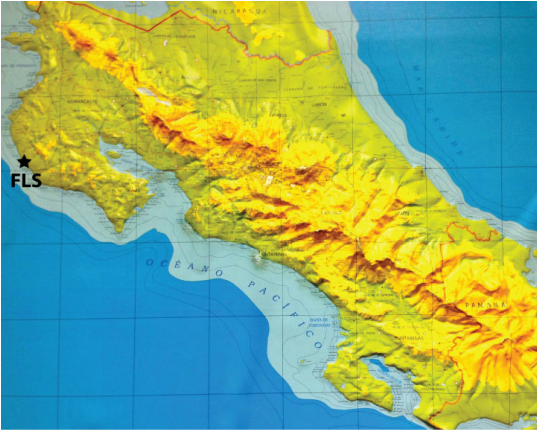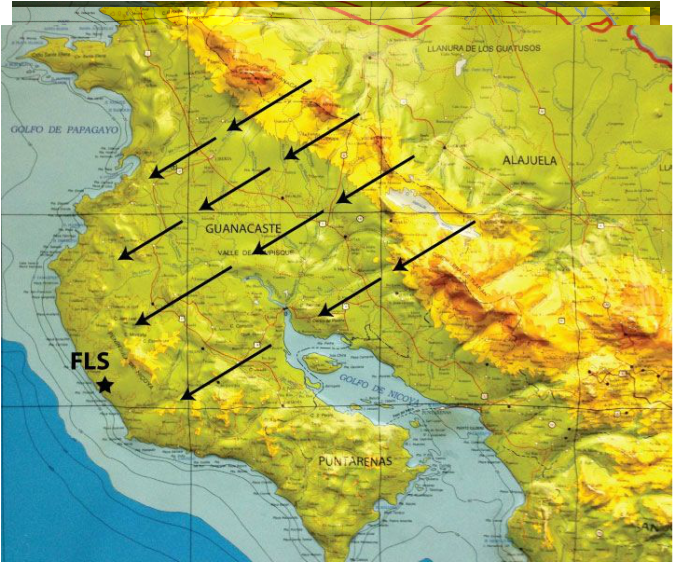Costa Rica's Weather

For a narrow country between two oceans, strong equatorial winds and high mountains combine to create many small Costa Rica microclimates.
The strong NE trade winds that flow off the Caribbean have a dominant impact on Costa Rica's weather.
In Costa Rica's far north, the winds cross wide lowlands to lose most of their moisture. The winds are thus hot and dry when they reach Lake Arenal and the many volcanos northwest of it. Lake Arenal's low elevation and the low gaps between the volcanoes allow the hot winds to flow through and then impact the entire northern Guanacaste coast.
Those dry winds are what make Guanacaste the number one visitor destination in Costa Rica. Tourists love its dryer climate than the rest of Costa Rica. But those winds also turn everything brown, and also make that northern coast area west of Liberia the hottest and driest in Costa Rica.
But the topography from Lake Arenal south to Panama is continuous high mountains that block those same winds. That's why the entire Pacific side of Costa Rica below the Gulf of Nicoya has much higher humidity levels. And again, that's why Guanacaste gets the majority of tourism visits.
The strong NE trade winds that flow off the Caribbean have a dominant impact on Costa Rica's weather.
In Costa Rica's far north, the winds cross wide lowlands to lose most of their moisture. The winds are thus hot and dry when they reach Lake Arenal and the many volcanos northwest of it. Lake Arenal's low elevation and the low gaps between the volcanoes allow the hot winds to flow through and then impact the entire northern Guanacaste coast.
Those dry winds are what make Guanacaste the number one visitor destination in Costa Rica. Tourists love its dryer climate than the rest of Costa Rica. But those winds also turn everything brown, and also make that northern coast area west of Liberia the hottest and driest in Costa Rica.
But the topography from Lake Arenal south to Panama is continuous high mountains that block those same winds. That's why the entire Pacific side of Costa Rica below the Gulf of Nicoya has much higher humidity levels. And again, that's why Guanacaste gets the majority of tourism visits.
Our Rio Rosario Weather
|
The famed Gold Coast starts 25 miles north of Finca Los Suenos and runs 40 miles up to Peninsula Papagayo. As you see, nothing stops the hot dry winds from hitting the coast area head-on. No mountains block the, winds so in the dry season, everything turns brown. It gets just 50” of rain a year and temps of 100 degrees F.
By contrast, our Rio Rosario basin is protected by a large 3200’ mountain - Vista Al Mar Peak - that sits 10 miles directly upwind from us. It forces the winds to rise and cool, often with a spillover cloud effect so mist and rain falls on its western slopes when it rains nowhere else. By contrast, our Rio Rosario basin gets about 90” of rain a year, with average year-round temperatures of 80-84 degrees F. It rarely reaches above the mid-90s. We enjoy six months of pure summer (Dec-May) and six months of pleasant green summer (June-Nov) with lots of sun. |
Our basin's lush tree canopies and green vegetation welcome wildlife and humans. You see it in the green, you feel it in the air, you hear it in the sounds. Most of our lots are high above sea level for much lower temperatures, light refreshing breezes and lower humidity levels. With near perfect year-round temperatures we hear the sounds of nature instead of the unnatural sounds of motors, compressors and fans. Indeed, we enjoy one of the finest climates anywhere on the Gunacaste coast.


